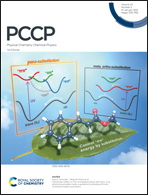Understanding the sodium ion transport properties, deintercalation mechanism, and phase evolution of a Na2Mn2Si2O7 cathode by atomistic simulation†
Abstract
Molecular dynamics (MD) together with the first principles method (DFT) reveal that Na+ is capable of migrating three dimensionally in a Na2Mn2Si2O7 cathode material. Migration along the a-axis and c-axis have the same mechanism, that is, alternating between the Na1 and Na2 route with a similar local environment and distance. Long-distance hopping between two Na2 atoms or between Na1 and Na2 atoms is crucial for continuous migration along the b-axis. Also, the anti-site phenomenon is identified, and it facilitates the migration of the Na ions. Four intermediate phases are determined according to the formation energy curve and, as a result, the voltage profile is predicted accurately. The state of charge (SOC) dependency of the Na+ energy shows that the mobility of Na+ is highly inhibited in the fully discharged state. Upon the deintercalation of sodium ions, Na+ is activated immediately. A maximal DNa+ value of 3.6 × 10−9 cm2 s−1 and a low energy barrier of ca. 0.26 eV at the deintercalation level of x = 0.25 are observed. Because of the scarcity of Na+, DNa+ experiences a sharp decrease at the end of deintercalation. Despite the low level of Na+ mobility in the range of 0.25 < x < 1, Na2Mn2Si2O7 is still a potential cathode material for use in sodium ion batteries (SIBs).



 Please wait while we load your content...
Please wait while we load your content...